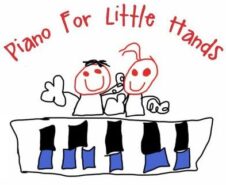Making Practicing With Your Preschooler Fun!
I once had a particularly adorable student in one of my preschool-programs, and about a year after she graduated, I got an email from her mom, telling me that her daughter was playing piano-class: She lined up her stuffed animals and pretended to be me, teaching them all piano:) The family had moved out of the city and back then, I had not yet figured out how to teach virtual lessons, so sadly it wasn’t possible for me to continue teaching her. She was clearly interested in learning more, and her mother was asking how they could encourage her.
Actually, her ‘playing piano class’ is a good example of how young children learn: They are constantly in practice-mode, pretending and practicing something, whether it’s cooking, holding a crayon or playing an instrument; it’s all practice! In my experience, the way to encourage them is to keep it playful: I don’t think we adults should interfere with children’s natural way of learning through play (there are already too many tests and grading happening in school) but we can make decisions about what materials and experiences they are exposed to: Art, stories, nature, animals, museums, the ballet, rock-climbing. This in return expands what materials and experiences they include in their play.
So, if you do want to encourage your young child to explore music more, here’s a few things that are great to do at home:
- Create a creative music corner:
Many of my preschool students have a piano or keyboard at home. How does it look; it an inviting place for a child to sit and play? Is it well-lit? Or is it covered in clutter or bare and boring? If your instrument is placed up against a wall, you can hang artwork that your child brings home from piano-class on the wall, programs from events or concerts you’ve taken them to, or other photos that have to do with music and the arts. Keep the books we use in class out and accessible, so they can flip through them.
My grandmother had a collection of hand-drawn portraits of stern-looking famous composers around her piano. But as a small child I absolutely loved those drawings! They sparked many interesting conversations between us about music and history. My dad collected Blue Note albums and hung some of the covers on the wall, as a daily reminder of great jazz musicians he loved and felt inspired by. And I, in turn, was inspired by his love of music. Whatever works for you, just let the music-corner be one of playful inspiration, rather than a blank, white wall.
- Keep it playful!
If you make time for more hands-on practice, just make sure to keep it playful and short. It’s always a good idea to ‘play dumb’ and let the child be the teacher. Let them practice how to clap quarter notes, half notes and rests or finding the letters on the keyboard by pretending you don’t know (perhaps you don’t!) Then let them show you. Or let them practice holding their hands round when they play, by holding your hands in all sorts of silly ways, and have them teach you how to do it correctly. If you play yourself, you can play the teachers duets that are printed in the books, which I usually play in class.
- Create Connection and context:
If, like centuries of parents, you try the ‘what did you learn in school today?’ approach, you are pretty sure to get the universal ‘nothing!’ response. I remember saying that same thing to my frustrated (educator) parents when I was small, because honestly: They weren’t there, and I felt it was none of their business! Instead, let the ‘creative music corner’ be a fun place to sit and explore things in the home, together or with friends who might come over. Just like school has become a place where your child learns music with friends, your music corner can be a special place in your home, something that connects your family. Keep it playful, be curious, and don’t make it another chore
If you would like to start a home-practice, feel free to email me, and I can send you a series of at-home lessons you can follow. Happy playing!
